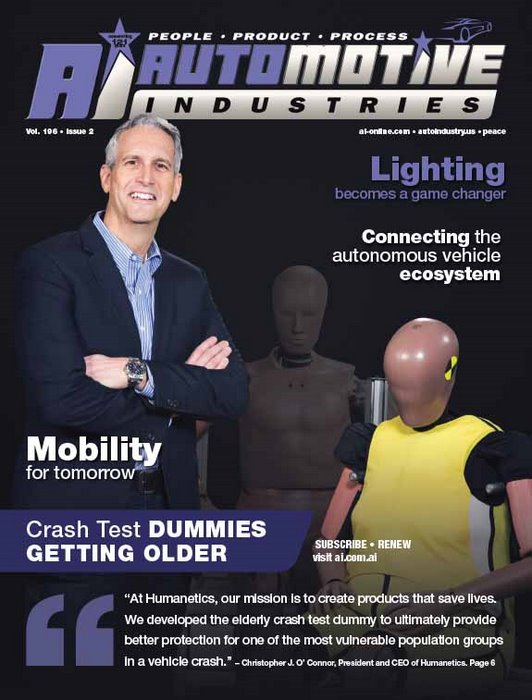
Car interiors, seats and safety belts that can adapt to drivers of different ages, genders, and sizes could well be the next major breakthrough in reducing injuries and deaths resulting from collisions.
Drivers and occupants are getting older on average around the world and studies are showing that safety ratings, such as those used by NHTSA, IIHS and Euro NCAP, may not tell the whole story for elderly or obese occupants. “The condition, size and shape of an individual are massively important in how severe their injuries are in any given crash,” says Dr. Stewart Wang Director of the International Center of Automotive Medicine (ICAM) at the University of Michigan. In Europe, protection of vulnerable car occupants including elderly and overweight persons is high on the agenda. “The specific requirements of the elderly (frailty, fragility) challenge the performance of existing safety systems that are not proven to be as effective for the elderly as they are for younger road users,” states Marcus Wisch, coordinator of the European Union-funded SENIORS (Safety ENhancing Innovations for Older Road Users) Project. “In an ageing society, SENIORS aims at providing the needed knowledge and enabling suitable tools to reduce the number of serious or fatal injuries to the elderly in road traffic accidents in the near future. The increase of the protection level of the elderly road users will be achieved by the thorough understanding of injury causes and mechanisms and by enhancing the introduction of advanced passive vehicle safety systems through the implementation of assessment tools based on crash data analyses, experiments with volunteers, PMHS studies and FE human body model simulations.“
While Anthropomorphic Test Devices (ATDs), commonly known as crash test dummies, such as THOR and WorldSID, developed over the past decades, are now used for current regulatory and industry testing procedures, Humanetics has been busy developing the next generation of ATDs. Humanetics works closely with NHTSA, EuroNCAP, the SENIORS Project, ICAM and other agencies and industry groups around the world to design future crash test dummies that reflect global changes in the demographics of drivers. Over the past few decades, the driving population has changed significantly in age and weight. As lifestyles and medical advancement evolve, baby boomers are now 65 or older and often overweight and still driving. A body of research has shown that elderly occupants are more likely to sustain internal injuries during certain crash scenarios. Humanetics’ new elderly dummy will allow automakers to enhance testing to better protect this growing at-risk population group.
In addition, Humanetics is one of the only companies to undertake ATD development in parallel with detailed Finite Element computer models. By working concurrently on both the ATD and the predictive simulation models, results from the virtual testing can be used in the development of the new ATD models. The new dummy and complementary simulation models will directly contribute to the improvement of vehicle safety, in support of: NHTSA’s “The Road Ahead” strategic plan, which states: “new tests will allow us to develop test criteria and apply tools such as virtual modeling to improve safety for a wider range of occupants based on age, stature, gender, and those with vulnerabilities due to medical issues”.
The first of its kind, the elderly ATD, is expected to change how we measure impact and crash events. It’s different in many ways, but the technology behind the construction may be another game changer.
Automotive Industries (AI) asked Christopher J. O’Connor, President and CEO of Humanetics, what can both government regulators and automakers do to ensure vehicles are safer for all occupants?
O’Connor: We are very pleased with the advancement of safety features in cars today as we have come a long way in the advancement of auto safety. However, the progress in reducing vehicular deaths has stalled recently. The introduction by NHTSA, IIHS and EuroNCAP of new tests with more advanced test devices such as the THOR, WorldSID and FLEX-PLI, will definitely help save lives. Automakers should also strongly consider the introduction of variable restraint systems; including seats, airbags and seatbelts that can automatically adapt according to the size, shape and age of the occupants. This will allow for the safest individualized restraint response during a given crash condition. AI: Why is it important to have “older” crash test dummies?
O’Connor: When you look at the crash test rating of a car you assume it will be the same for all drivers, but in fact it may not be. Different body types may react differently to the airbags and to the seatbelt itself in a given crash event. Our newest dummies, the elderly dummy and the obese dummy, are intended to reflect those physical differences and provide additional life-saving tools for automakers to use to test their vehicles.
AI: What has changed?
O’Connor: Research and development over the past few decades has resulted in highly advanced dummies such as THOR and WorldSID for frontal and side impact applications. Like their predecessors, these dummies are based on anthropometry of what was considered a “healthy, average” adult male and small female population. When crash test dummies were originally designed it wasn’t envisaged that people would be driving in their 70s, 80s, and 90s. But they are, and the driving population has changed significantly in terms of both age and weight. As lifestyles and medical advancement evolve with time, people are living longer and more sedentary lives, resulting in an older, heavier population.
AI: Do we have an idea of the numbers involved?
O’Connor: Statistically, there were more than 40 million licensed drivers aged 65 and older in the United States in 2015 (U.S. Department of Transportation). This represents 18.4% – or nearly one in every five drivers – on the American roads. In 2014, more than 5,700 older adults were killed and more than 236,000 were treated in emergency rooms for motor vehicle crash injuries. This amounts to 16 older adults killed and 648 injured in crashes on average every day.
AI: Please tell us more about your elderly dummy.
O’Connor: Humanetics embarked on a project to create an ATD design to reflect the anthropometry of an elderly 70 year-old small female driver by using research conducted by ICAM and UMTRI (University of Michigan Transportation Research Institute). Utilizing the anthropomorphic data provided by UMTRI, some hardware cues from the small female WorldSID and with a newly designed organ system, our elderly dummy will allow more precise measurements of internal injuries sustained in automotive accidents for this specific occupant group.
Humanetics has also utilized 3D printing technology and manufacturing methodology to produce many of the elderly components to expedite this development initiative. By printing materials such as plastics, foams, and even metals, complex geometric designs and consistent performance characteristics can easily be obtained. This research, coupled with new production techniques, may ultimately serve to enhance the designs of the next generation of dummies by incorporating new manufacturing technologies that can produce a more humanlike anatomy. The first prototype of the elderly dummy is currently undergoing testing by OEMs and academia, such as Honda and Ohio State University (OSU), to provide a baseline for performance, durability and biofidelity for its further development.
AI: How is medical research by ICAM assisting the design of elderly dummies?
O’Connor: Humanetics is working closely with ICAM to define anatomical features and verify performance attributes with real-world injury feedback in order to understand the dynamic properties of internal human organs such as the liver and spleen. To further understand loading parameters and organ responses, comparison work is also being conducted at Humanetics using biological equivalents.
AI: What about research elsewhere in the world?
O’Connor: The company is closely involved in research programs such as SENIORS to address similar types of concerns in other regions of the world. It is Humanetics’ goal to collaborate with other safety organizations worldwide to develop products that best reflect the current population. Ultimately, we are committed to promoting vehicle safety and saving lives in every global market and geographic region until fatality rates equal zero





More Stories
ROHM’s PMICs for SoCs Adopted in Reference Designs for Telechips’ Next-Generation Cockpits
Southfield Classics utilizes Ampere EV engineering to become the first manufacturer to achieve Low Volume Vehicle Manufacturer Certification
Mosaic Click board from MIKROE delivers global coverage multi-band and multi-constellation tracking ability